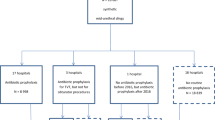Abstract
Introduction and hypothesis
The objective of this study was to determine if prophylactic antibiotic use before midurethral sling procedures reduces infectious complications.
Methods
In this double-blinded randomized trial, we compared infectious complications between women who received cefazolin and placebo before midurethral sling procedures.
Results
The study was halted due to low rate of infectious outcomes seen at the first scheduled interim analysis. We enrolled 29 women in the cefazolin group and 30 in the placebo group. Total follow-up was 6 months (3–24 months). The groups were similar at the baseline. There was no statistically significant difference between the cefazolin and placebo groups, respectively, with respect to wound infections [1 (3.3%) and 0 (0%)], mesh exposure [0 (0%) and 1 (3.5%)], and bacteriuria [3 (10%) and 1 (3.5%)].
Conclusion
Because infection rates are low in both cefazolin and placebo groups, omitting preoperative antibiotics for midurethral slings may be justified.
Similar content being viewed by others
References
Ulmsten U, Henriksson L, Johnson P et al (1996) An ambulatory surgical procedure under local anesthesia for treatment of female urinary incontinence. Int Urogynecol J Pelvic Floor Dysfunct 7:81–86
Richter HE, Albo ME, Zyczynski HM et al (2010) Retropubic versus transobturator midurethral slings for stress incontinence. N Engl J Med 362:2066–2076
ACOG Committee on Practice Bulletins—Gynecology (2009) ACOG practice bulletin no. 104: antibiotic prophylaxis for gynecologic procedures. Obstet Gynecol 113:1180–1189
Committee on Antimicrobial Agents, Canadian Infectious Disease Society (1994) Antimicrobial prophylaxis in surgery. Can Med Assoc J 151:925–931
Wolf JS Jr, Bennett CJ, Dmochowski RR et al (2008) Urologic surgery antimicrobial prophylaxis best practice policy panel. Best practice policy statement on urologic surgery antimicrobial prophylaxis. J Urol 179:1379–1390
Swartz M, Ching C, Gill B, Li J et al (2010) Risk of infection after midurethral synthetic sling surgery: are postoperative antibiotics necessary? Urology 75:1305–1308
Persson J, Iosif C, Wolner-Hanssen P (2002) Risk factors for rejection of synthetic suburethral slings for stress urinary incontinence: a case control study. Obstet Gynecol 99:629–634
Tamussino KF, Hanzal E, Kölle D, Austrian Urogynecology Working Group et al (2001) Tension-free vaginal tape operation: results of the Austrian registry. Obstet Gynecol 98(5 Pt 1):732–736
Barber MD, Kleeman S, Karram MM et al (2008) Transobturator tape compared with tension-free vaginal tape for the treatment of stress urinary incontinence. Obstet Gynecol 111:611–621
Ross S, Robert M, Swaby C et al (2009) Transobturator tape compared with tension-free vaginal tape for stress incontinence. Obstet Gynecol 114:1287–1294
Houwert RM, Roovers JPWR, Venema PL et al (2010) Outcome and complications of retropubic and transobturator midurethral slings translated into surgical therapeutic indices. Am J Obstet Gynecol 202:75–77
Ingber MS, Vasavada SP, Firoozi F et al (2010) Incidence of perioperative urinary tract infection after single-dose antibiotic therapy for midurethal slings. Urology 76:830–834
Nygaard I, Brubaker L, Chai TC, et al (2011) Risk factors for urinary tract infection following incontinence surgery. Int Urogynecol J Pelvic Floor Dysfunct (in press)
Hong E, Rubin R, Jones KA, et al (2010) Is antibiotic prophylaxis necessary for midurethral sling procedures? A case series. Abstract published in Female Pelvic Medicine & Reconstructive Surgery 16 (supp 2): S146. Poster 123 presented at 31st Annual Meeting of American Urogynecological Society September 30–October 2, 2010
Cundiff GW, McLennan MT, Bent AE (1999) Randomized trial of antimicrobial prophylaxis for combined urodynamics and cystourethroscopy. Obstet Gynecol 93:749–752
Lowder JL, Burrows LJ, Howden NL et al (2007) Prophylactic antimicrobials after urodynamics in women: a decision analysis. Int Urogynecol J Pelvic Floor Dysfunct 18:159–164
Grimes DA, Schulz KF (2001) Antibiotic prophylaxis for intrauterine contraceptive device insertion. Cochrane Database Syst Rev: CD001327
Acknowledgement of financial support
None.
Conflicts of interest
None.
Author information
Authors and Affiliations
Corresponding author
Rights and permissions
About this article
Cite this article
Harmanli, O., Boyer, R.L., Metz, S. et al. Double-blinded randomized trial of preoperative antibiotics in midurethral sling procedures and review of the literature. Int Urogynecol J 22, 1249–1253 (2011). https://doi.org/10.1007/s00192-011-1500-6
Received:
Accepted:
Published:
Issue Date:
DOI: https://doi.org/10.1007/s00192-011-1500-6




